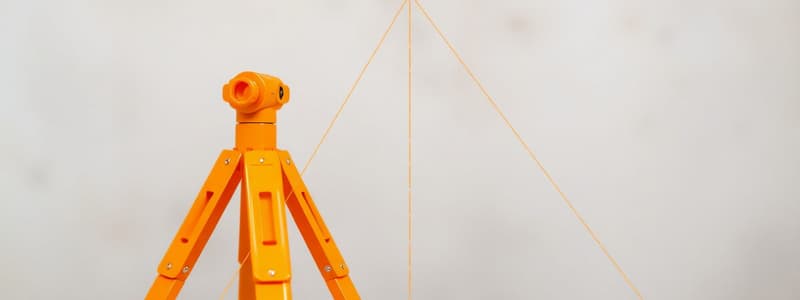Podcast
Questions and Answers
What is the primary purpose of triangulation in surveying?
What is the primary purpose of triangulation in surveying?
- To calculate elevation changes over time
- To determine precise locations and distances (correct)
- To establish boundaries of properties
- To create detailed maps of terrain
Which phase of signals is crucial for accurate triangulation measurements?
Which phase of signals is crucial for accurate triangulation measurements?
- Phase of elevation
- Phase of propagation (correct)
- Phase of amplitude
- Phase of interference
What does the term 'inter-visibility' refer to in the context of triangulation?
What does the term 'inter-visibility' refer to in the context of triangulation?
- The mutual visibility between triangulation stations (correct)
- The ability to see over long distances
- The measurement of signal strength between stations
- The alignment of multiple towers
Which of the following is NOT a component of triangulation figures?
Which of the following is NOT a component of triangulation figures?
When conducting reconnaissance for a triangulation survey, which factor is least important?
When conducting reconnaissance for a triangulation survey, which factor is least important?
Flashcards are hidden until you start studying
Study Notes
Triangulation: Principles
- A method for determining the precise location of points by measuring angles between them.
- Based on the principle of geometric relationships between angles and sides of triangles.
- Essential for accurate surveying and mapping.
Classification of Triangulation Systems
- Primary Triangulation: Establishes a network of control points with high accuracy, covering large areas.
- Secondary Triangulation: Densifies the primary network, providing control points for more detailed surveys.
- Tertiary Triangulation: Further densifies the network, providing control points for local surveys.
Triangulation Figures
- Triangles: Basic building blocks of a triangulation system, determined by measuring three angles.
- Quadrilaterals: Four points connected by four sides, providing redundancy and improved accuracy.
- Polygons: Figures with more than four sides, offering greater flexibility and coverage.
Station Choice
- Visibility: Stations should have clear lines of sight to other stations.
- Accessibility: Stations should be readily accessible for setup and measurement.
- Stability: Stations should be located on stable ground to minimize movement.
Phases of Signals
- Day Signals: Used during daylight hours, often made of white flags.
- Night Signals: Used during nighttime, employing electric lamps or other illuminated objects.
Towers
- Types: Steel, wooden, or composite structures.
- Purpose: Elevate signal targets for better visibility.
- Height: Determined by the distance and terrain to ensure visibility.
Satellite Stations
- Purpose: To connect different triangulation networks or establish a network in a remote area.
- Signals: Often transmitted via radio waves or electromagnetic radiation.
Reduction to Center
- Adjustments for measurements taken from a point other than the actual station.
- Corrections applied to observed angles to account for deviations by the instrument.
- Uses calculations based on instrument position, target position, and the distance between the station and the instrument.
Field Work
- Reconnaissance: Conducting a preliminary survey to plan triangulation network.
- Inter-visibility: Ensuring visibility between stations, often achieved through clearing vegetation.
Angular Measurements
- Use of Theodolite: A precise instrument for measuring horizontal and vertical angles.
- Procedures: Utilizing accurate methods like repetition method to minimize measurement errors.
- Targetting: Focusing on signals accurately to ensure precise measurements.
Base Net
- Ground-based measurement: Accurate measurement of a baseline distance using precise instruments.
- Purpose: Provides a starting point for calculating all other distances in the triangulation system.
Extension of Base Net
- Extending the Base Line: Establishing new baselines by connecting existing ones through accurately measured triangles.
- Purpose: To extend the base line to different regions within the triangulation network.
Studying That Suits You
Use AI to generate personalized quizzes and flashcards to suit your learning preferences.




